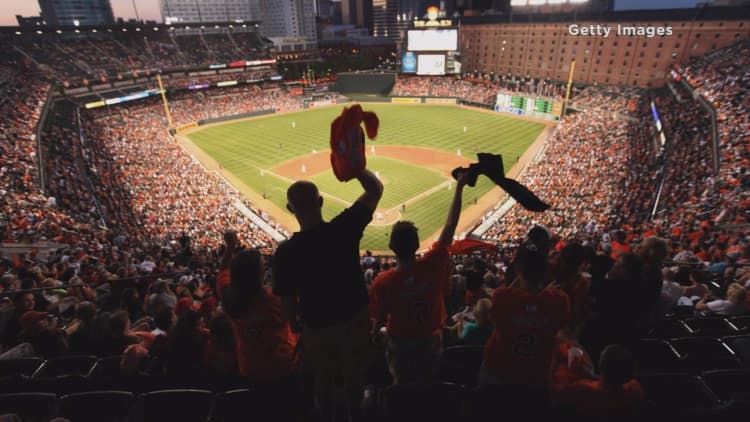Opening day for Major League Baseball ushers fans back into stadiums. If they live within walking distance of a ballpark, odds are their real estate is more valuable, according to Trulia.
"Urban stadiums that are very walkable do really well," said David Weidner, who authored the report for the San Francisco-based real estate company. "It helps a lot if there are developments linked to stadiums around them. A lot of these newer stadiums have residential parts to them, retail, shopping."
Trulia researchers took a snapshot at the beginning of March, looking at home values within a mile of stadiums compared with the broader metropolitan area. They found neighborhoods surrounding 18 of 29 Major League Baseball stadiums (excluding Toronto) had higher median home values compared with the averages in the cities. Overall, the areas around ballparks had home values 15 percent higher than the greater metros.
Where Home Values Are Highest Around MLB Stadiums
| Name of Team and Stadium | Metro Location | Year Opened | Median Metro Home Value | Median Home Value Near Stadium | % Stadium Home Value vs. Metro Home Value |
|---|---|---|---|---|---|
| New York Yankees Yankee Stadium | New York, NY | 2009 | $407,379 | $740,106 | 81.70% |
| Houston Astros Minute Maid Park | Houston, TX | 2000 | $171,162 | $306,686 | 79.20% |
| Boston Red Sox Fenway Park | Boston, MA | 1912 | $395,937 | $658,396 | 66.30% |
| Cincinnati Reds Great American Ballpark | Cincinnati, OH | 2003 | $144,210 | $226,140 | 56.80% |
| Detroit Tigers Comerica Park | Detroit, MI | 2000 | $62,101 | $92,145 | 48.40% |
| Pittsburgh Pirates PNC Park | Pittsburgh, PA | 2001 | $131,293 | $175,461 | 33.60% |
| Colorado Rockies Coors Field | Denver, CO | 1995 | $329,568 | $439,351 | 33.30% |
| Philadelphia Phillies Citizens Bank Park | Philadelphia, PA | 2004 | $138,670 | $176,572 | 27.30% |
| Chicago Cubs Wrigley Field | Chicago, IL | 1914 | $208,939 | $255,475 | 22.30% |
| Washington Nationals Nationals Park | Washington, DC | 2008 | $361,061 | $415,434 | 15.10% |
Source: Source: Trulia
New York's Yankee Stadium topped Trulia's list, with home prices 82 percent higher near the stadium, boosted by its proximity, but not its walkability, to the pricey Upper East Side. Home values near the Houston Astros Minute Maid Park were 80 percent higher than the region. The Colorado Rockies' Coors Field, built in 1995, is in Denver's vibrant LoDo neighborhood; prices near the stadium are 33 percent higher than the greater metro area.
While the Baltimore Orioles led the field with the stadium building boom in 1992, it doesn't look like a home run for the area. Trulia found home values by Camden Yards were 16 percent lower than the greater metro area; $211,724 near the stadium versus $251,724 for the city.

"It's a wonderful stadium to go to a game in, but it's actually a pretty good example of one where there hasn't been any local neighborhood development around it," said Victor Matheson, economics professor at the College of the Holy Cross in Worcester, Massachusetts. "The good and the bad about Camden Yards is it has all these great amenities inside the stadium, but the better the crab cakes are inside the stadium, the less need there is to go to a bar across the street or local restaurant after the game instead."
Older stadiums surrounded by industrial areas and large parking lots tend to have properties nearby with lower value. Homes near the Oakland Athletics' Coliseum were 56 percent below the broader metro area. The Atlanta Braves' Turner Field, opened in 1997, has a reputation as a traffic nightmare and home values are 28 percent lower than the broader market. The team is moving to a new park in 2017 that's being touted as the crown jewel in a "live, work, play" development.
While stadiums may generate amenities like bars and restaurants, neighbors also have to cope with more traffic, less parking and litter left by fans. The reason for higher property values near stadiums is often unclear. Did the stadium drive higher prices, or was it placed in an area that was experiencing growth anyway? "Most of these new facilities, they are put somewhere for a reason and it could be that they are placing new stadiums in areas that they think are going to take off," said Brad Humphreys, economics professors at West Virginia University.
The neighborhoods that may benefit from a stadium's presence are the ones that can embrace average crowds of 30,366 at each of the 81 regular season home games. But stadiums are typically built with an eye to their bottom line, not the homes nearby. "You're a team, you're building a stadium, you're not in the urban renewal business, you're in the let's generate-revenue-for-my-team business," said Matheson.


